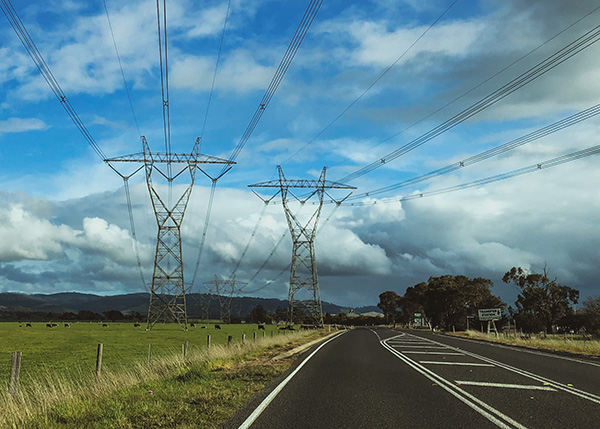 With over 6,500 kilometres of transmission lines in Victoria our volunteers have experience fighting fires around transmission lines.
With over 6,500 kilometres of transmission lines in Victoria our volunteers have experience fighting fires around transmission lines.
Methods and approaches used to fight these fires vary depending on the forecast weather conditions, fire behaviour and location. CFA has standard operating procedures in place for how our members can work safely around high-voltage transmission lines and large pylons.
While there are restrictions in operating near transmission lines there are alternatives to using water in firefighting. These include the use of heavy machinery to remove fuel such as grass, bushes and scrub from the land to stop the fire from reaching assets such as transmission lines, buildings and other critical infrastructure. Firefighting aircraft can operate around high-voltage transmission lines where that is part of the strategy.
CFA is not the approval authority for new infrastructure being built or the location of transmission lines, but we do provide important safety advice and guidance to relevant authorities. As an emergency service, our focus is on protecting communities and ensuring that are members are always safe, which includes providing them with the information and direction they need in these environments.
Frequently asked questions (FAQs)
If there is a bushfire, is it safe to fight a fire if we have transmission lines on our property?
There is no specific CFA direction that says you can’t fight fires if you have transmission lines on your property. In the case of a bushfire response, an assessment will be made by the Incident Controller and if it is considered safe to do so, responding crews can operate near transmission lines.
CFA operational procedures advise not to directly attack fires in transmission line easement areas and crew members should maintain a safe working distance of at least 25 metres from lines or outside of easement areas, whichever is greater.
How close can we get to transmission lines when fighting a fire?
The CFA operational procedures states that crew members should maintain a safe working distance of at least 25 metres from lines. In the interests of safety, it is recommended to maintain a minimum distance of 25 metres from transmission lines or a distance outside of easement area if greater, when fighting fires.
Smoke from fires near or under transmission lines can also create electrical arcs or flashovers. Flashovers are potentially life threatening to someone standing nearby. If the power is isolated and the lines are de-energised, the risk is greatly reduced.
What is CFA’s role in the transmission line construction process?
During the planning process, CFA will likely provide advice on the bushfire risk. This may be as a referral body, or as part of a technical reference group, or in the form of a more formal planning submission. CFA’s role in the planning process will vary depending on several factors, including the requirements of the planning scheme and the location of the proposed transmission line.
Do new transmission lines increase the risk of bushfires?
High voltage transmission line construction poses fire ignition risks. The Transmission Network Service Providers (TNSP) Bushfire Mitigation Plan outlines detailed actions to mitigate fire risks during construction, including specific controls mandated by the Country Fire Authority Act 1958 (Vic) for work during fire danger periods. Ongoing management and mitigation of fire risk are essential throughout the operation and maintenance of transmission lines.
hide
Page last updated: Thursday, 14 March 2024 7:25:17 PM